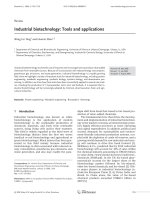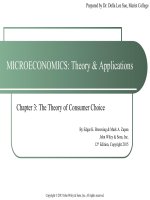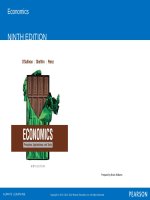Economics principles tools and applications 9th by sullivan sheffrin perez chapter 03
Bạn đang xem bản rút gọn của tài liệu. Xem và tải ngay bản đầy đủ của tài liệu tại đây (2.83 MB, 18 trang )
Economics
NINTH EDITION
Chapter 3
Exchange and Markets
Prepared by Brock Williams
Copyright © 2017, 2015, 2012 Pearson Education, Inc. All Rights Reserved
Learning Objectives
3.1 Use opportunity cost to explain the rationale for specialization and trade.
3.2 Explain how markets allow specialization and trade.
3.3 List the roles of government in a market economy.
Copyright © 2017, 2015, 2012 Pearson Education, Inc. All Rights Reserved
3.1 COMPARATIVE ADVANTAGE
AND EXCHANGE (1of 4)
Specialization and the Gains from Trade
•
•
PRINCIPLE OF OPPORTUNITY COST
The opportunity cost of something is what you sacrifice to get it.
Copyright © 2017, 2015, 2012 Pearson Education, Inc. All Rights Reserved
3.1 COMPARATIVE ADVANTAGE
AND EXCHANGE (2 of 4)
►FIGURE 3.1
Self-Suf cient
Specialization and the Gains from Trade
Fred produces and consumes 4
coconuts and 24 fish.
Specialize: Fred in Fish,
Katein Coconuts
Fred specializes and produces 36
fish.
Exchange10 Fish and 5 Coconuts
Fred gives Kate 10 fish for 5 coconuts.
He gains 1 coconut and 2 fish.
Comparative advantage
The ability of one person or nation to produce a good at a lower
opportunity cost than another person or nation.
•
(4)
(5)
Fred has a comparative advantage in producing fish.
His opportunity cost of fish is one-third coconut per fish, compared to 1
coconut per fish for Kate
•
(24)
(36)
(26)
Kate has a comparative advantage in coconuts.
Kate produces and consumes 1
coconut and 5 fish.
Her opportunity cost of coconuts is 1 fish per coconut, compared to 3 fish
Kate specializes and produces 6
coconuts.
Kate gives Fred 5 coconuts for 10 fish.
She gains 5 fish.
per coconut for Fred.
(1)
(6)
(1)
(5)
▲
(10)
FIGURE 3.1 Specialization and the Gains from Trade
MyEconLab Real-time data
Copyright © 2017, 2015, 2012 Pearson Education, Inc. All Rights Reserved
EC: Saw
EC:
Latvia: Saw
Latvia:
3.1 COMPARATIVE ADVANTAGE
AND EXCHANGE (3 of 4)
PRINCIPLE OF VOLUNTARY EXCHANGE
A voluntary exchange between two people makes both people better off.
Comparative Advantage versus Absolute Advantage
•
Comparative advantage
The ability of one person or nation to produce a good at a lower opportunity cost than another person or nation.
•
Absolute advantage
The ability of one person or nation to produce a product at a lower resource cost than
Copyright © 2017, 2015, 2012 Pearson Education, Inc. All Rights Reserved
another person or nation.
3.1 COMPARATIVE ADVANTAGE
AND EXCHANGE (4 of 4)
The Division of Labor and Exchange
In his 1776 book, An Inquiry into the Nature and Causes of the Wealth of Nations, Adam Smith noted that specialization actually increased
productivity through the division of labor.
Smith listed three reasons for productivity to increase with specialization, with each worker performing a single production task:
1. Repetition. The more times a worker performs a particular task, the more proficient the worker becomes at that task.
2. Continuity. A specialized worker doesn‘t spend time switching from one task to another. This is especially important if switching tasks requires a change in
tools or location.
3. Innovation. A specialized worker gains insights into a particular task that lead to better production methods.
Copyright © 2017, 2015, 2012 Pearson Education, Inc. All Rights Reserved
Comparative Advantage and International Trade
•
Import
A product produced in a foreign country and purchased by residents of the home country.
•
Export
A product produced in the home country and sold in another country.
Copyright © 2017, 2015, 2012 Pearson Education, Inc. All Rights Reserved
APPLICATION 1
Absolute Disadvantage and Comparative Advantage in Latvia
APPLYING THE CONCEPTS #1: What is the rationale for specialization and trade?
•
Latvia in the 1990s was much less productive than nations in the European Community. The question is, Why would a member of the EC, whose workers
are more productive than Latvian workers in the production of all goods, buy any products from Latvia?
•
Although the EC has an absolute advantage in both products, it has a comparative advantage (a lower opportunity cost) in grain: the opportunity cost of
one unit of grain is 6 units of saw timber in the EC, compared to 20 units of saw timber in Latvia. Latvia has a comparative advantage in saw timber: the
opportunity cost is 1/20 units of grain in Latvia, compared to 1/6 units of grain in the EC.
•
Based on the notion of comparative advantage, we know that both the EC and Latvia can be made better off if the EC produces grain in exchange for saw
timber produced by Latvia.
Copyright © 2017, 2015, 2012 Pearson Education, Inc. All Rights Reserved
Outsourcing
When a domestic firm shifts part of its production to a different country, we say the firm is outsourcing or offshoring.
Some recent studies of outsourcing have reached a number of conclusions:
•
The loss of domestic jobs resulting from outsourcing is a normal part of a healthy
economy, because technology and consumer preferences
change over time.
•
The jobs lost to outsourcing are at least partly offset by jobs gained through insourcing, jobs that are shifted from overseas to the United States.
•
The cost savings from outsourcing are substantial, leading to lower prices for
increased output at least partly offset the jobs lost to outsourcing.
Copyright © 2017, 2015, 2012 Pearson Education, Inc. All Rights Reserved
consumers and more output for firms. The jobs gained from
3.2 MARKETS (1 of 3)
•
Market economy
An economy in which people specialize and exchange goods and services in markets.
Although it appears that markets arose naturally, a number of social and government inventions have made them work better:
•
•
•
•
Contracts specify the terms of exchange, facilitating exchange between strangers.
Insurance reduces the risk entrepreneurs face.
Patents increase the profitability of inventions, encouraging firms to develop new products and production processes.
Accounting rules provide potential investors with reliable information about the financial performance of a firm.
Copyright © 2017, 2015, 2012 Pearson Education, Inc. All Rights Reserved
3.2 MARKETS (2 of 3)
Virtues of Markets
•
Centrally planned economy
An economy in which a government bureaucracy decides how much of each good to produce, how to produce the good, and who gets the good.
Under a market system, decisions are made by the millions of people who already have information about consumers’ desires, production technology, and
resources. These decisions are guided by prices of inputs and outputs.
Prices provide signals about the relative scarcity of a product and help an economy respond to scarcity.
The market system works by getting each person, motivated by self-interest, to produce products for other people.
Copyright © 2017, 2015, 2012 Pearson Education, Inc. All Rights Reserved
3.2 MARKETS (3 of 3)
The Role of Entrepreneurs
Entrepreneurs play a key role in a market economy.
▪ Prices and profits provide signals to entrepreneurs about what to produce.
▪ If a product becomes popular, competition among consumers to obtain it will increase its price and increase the profits earned by firms
producing it.
▪ Entrepreneurs will enter the market and increase production to meet the higher demand, switching resources from the production of other
products.
▪ As entrepreneurs enter the market, they compete for customers, driving the price back down to the level that generates just enough profit
for them to remain in business.
Copyright © 2017, 2015, 2012 Pearson Education, Inc. All Rights Reserved
APPLICATION 2
The Market for Meteorites
APPLYING THE CONCEPTS #2: Why do markets develop?
•
When a meteoroid, a chunk of debris in the solar system, enters the earth’s atmosphere it becomes a meteor, and if a meteor reaches the ground and
survives impact, it becomes a meteorite.
•
The market for meteorites is highly organized. Meteorites have been hitting the earth for millions of years, and they can still be found in many desert areas.
In Morocco, people bring meteorites picked up in the desert to local dealers, who then sell them to the public through websites and eBay. And there are
professional meteorite hunters, who listen for news of meteorite showers and then travel to the landfalls to gather fresh meteorites.
•
The market price of meteorites varies from a few dollars per gram for the most common types to Hundreds of dollars per gram for the rarest, including
objects that originated from Mars and the moon.
Copyright © 2017, 2015, 2012 Pearson Education, Inc. All Rights Reserved
3.3 MARKET FAILURE AND
THE ROLE OF GOVERNMENT
(1 of 3)
Although markets often operate efficiently on their own, sometimes they do not.
Market failure happens when a market doesn't generate the most efficient outcome.
There are several sources of market failure and possible responses by government. Here is a preview of the topics:
•
Pollution.
•
Public goods.
•
Imperfect information.
•
Imperfect competition.
Copyright © 2017, 2015, 2012 Pearson Education, Inc. All Rights Reserved
3.3 MARKET FAILURE AND
THE ROLE OF GOVERNMENT
(2 of 3)
Government Enforces the Rules of Exchange
•
To facilitate exchange, the government helps to enforce contracts by maintaining a legal system that punishes people who violate them. This system
allows people to trade with the confidence that the terms of the contracts they enter will be met.
•
In the case of consumer goods, the implicit contract is that the product is safe to use. The government enforces this implicit contract through product
liability or tort law.
•
The government disseminates information about consumer products.
•
The government uses antitrust policy to foster competition.
Copyright © 2017, 2015, 2012 Pearson Education, Inc. All Rights Reserved
3.3 MARKET FAILURE AND
THE ROLE OF GOVERNMENT
(3 of 3)
Government Can Reduce Economic Uncertainty
•
Given the uncertainty of market economies, most governments fund a “social safety net” that provides for citizens who fare poorly in markets.
•
Of course, there are private responses to economic uncertainty. For example, we can buy our own insurance to cover losses.
•
Some types of insurance, however, are unavailable in the private insurance market. As a result, the government steps in to fill the void.
Copyright © 2017, 2015, 2012 Pearson Education, Inc. All Rights Reserved
APPLICATION 3
Property Rights and Urban Slums
APPLYING THE CONCEPTS #3: What is the role of government in a market
economy?
o
One role of government is to About 10 percent of the world’s population lives in urban squatter settlements, with little security in housing. A household that occupies public land
could be relocate at any time, and would lose all f its immobile possessions including a dwelling.
o
One policy option is property titling, that is, granting ownership of a dwelling to its occupant. The person who owns a dwelling reaps all the benefits of regular repair and
maintenance, including any increase in market value.
o
Granting property rights increases the incentive for property maintenance.
o
A study in Peru showed evidence that urban property titling increases investment in housing repair and maintenance.
Copyright © 2017, 2015, 2012 Pearson Education, Inc. All Rights Reserved
KEY TERMS
Absolute advantage
Centrally planned economy
Comparative advantage
Export
Import
Market economy
Copyright © 2017, 2015, 2012 Pearson Education, Inc. All Rights Reserved









